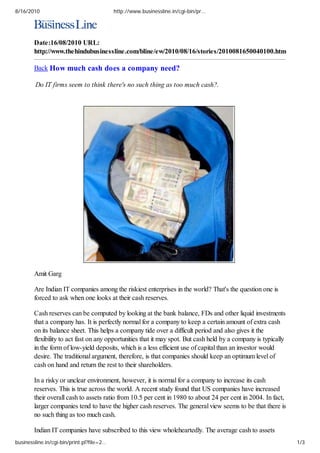
Why IT Firms May Be Holding Too Much Cash
- 1. 8/16/2010 http://www.businessline.in/cgi-bin/pr… Date:16/08/2010 URL: http://www.thehindubusinessline.com/bline/ew/2010/08/16/stories/2010081650040100.htm Back How much cash does a company need? Do IT firms seem to think there's no such thing as too much cash?. Amit Garg Are Indian IT companies among the riskiest enterprises in the world? That's the question one is forced to ask when one looks at their cash reserves. Cash reserves can be computed by looking at the bank balance, FDs and other liquid investments that a company has. It is perfectly normal for a company to keep a certain amount of extra cash on its balance sheet. This helps a company tide over a difficult period and also gives it the flexibility to act fast on any opportunities that it may spot. But cash held by a company is typically in the form of low-yield deposits, which is a less efficient use of capital than an investor would desire. The traditional argument, therefore, is that companies should keep an optimum level of cash on hand and return the rest to their shareholders. In a risky or unclear environment, however, it is normal for a company to increase its cash reserves. This is true across the world. A recent study found that US companies have increased their overall cash to assets ratio from 10.5 per cent in 1980 to about 24 per cent in 2004. In fact, larger companies tend to have the higher cash reserves. The general view seems to be that there is no such thing as too much cash. Indian IT companies have subscribed to this view wholeheartedly. The average cash to assets businessline.in/cgi-bin/print.pl?file=2… 1/3
- 2. 8/16/2010 http://www.businessline.in/cgi-bin/pr… ratio for three of the top IT companies has increased from 22 per cent to 31 per cent over the last five years. One can argue that cash to assets is not the only ratio that a services company would look at. Some analysts prefer the cash to operating expense ratio. This ratio tells us how many months a company would be able to sustain its current expenses without any revenues whatsoever. Those numbers don't look particularly good either (i.e, the lower, the better). Over the last five years, the cash to expenses ratio has increased from 20 per cent (2.4 months) to 40 per cent (4.8 months). In one case, the number is as high as 71 per cent (8.5 months). What is the need for this increase in cash reserves? Let's tick off the reasons. One of them could be the “war chest” argument — keeping money aside for acquisition opportunities. However, there have been very few large acquisitions in the sector, and it seems unlikely that this trend will change significantly. Besides, in the event of a large acquisition, it would not be that difficult to raise money from the market. Some would argue that it would also create more discipline in acquisitions. So acquisitions can't be the reason — there seems neither the intent nor the requirement. Another reason could have been investments in infrastructure creation. But given the recession, few companies are expanding their facilities in any meaningful manner. There are also several rental opportunities available today — a consequence of overbuild in the real-estate sector. So a company doesn't necessarily need to build capacity ahead of demand. The other reasons would need to be operational. Bad debts and longer collections cycles could be one of the risks of the environment. But that doesn't seem to be the case either. In fact, most large IT companies have been tightening their risk assessment and collections processes over the years and have better collection ratios than they did a few years ago. Similarly, companies have moved to create tighter performance management systems and a more variable employee salary structure. businessline.in/cgi-bin/print.pl?file=2… 2/3
- 3. 8/16/2010 http://www.businessline.in/cgi-bin/pr… There have also been increases in sub-contracting — which allows for (relatively) short-term changes in staffing. As a result, an IT company does have some ability to align its cost structure with the revenue situation. If the need arose, they could reduce their staff costs. So there really is no justifiable argument for the incredible increase we've seen in cash reserves. In fact, there is also a perspective that the risk level in a larger services company is actually lower – since the variability of a portfolio is lower than that of an individual account. The tendency to stock-up on cash then boils down to a heightened risk perception about the environment and the fact that investors seem fairly tolerant of cash hoarding practices. It is, however, a very costly practice — and one that will hopefully change. The author is a Director with MXV Consulting. He can be reached at amit_garg@mxv.in Related Stories: IT majors see higher revenues from global retailers Little improvement in debt collection time for IT majors © Copyright 2000 - 2009 The Hindu Business Line businessline.in/cgi-bin/print.pl?file=2… 3/3